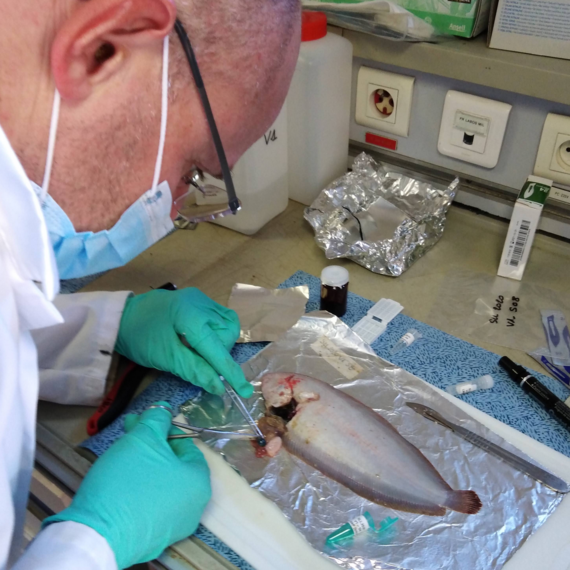SELI (Since 2016)
Monitoring of biological effects induced by chemical contamination
Ifremer Coordination | Type of project | Financing | Project duration | Link |
A. Mauffret (DCSMM) | National | Agence de l’Eau | Depuis 2016 |
The "SELI" monitoring has been set up by the unit (BE, now CCEM) since 2016 to inform on the integrative biological effects of chemical contamination in marine organisms (fish and bivalves). These data contribute to 1) Descriptor 8 GES assessment in the MSFD context 2) biological effect monitoring in the ICES context, e.g. they are used in the OSPAR Quality Status Report 2023. SELI is implemented in 3 French subregions, the general idea is to visit each subregion every 3 years):
- Bays of Seine (2018 and 2021) and Somme (2021) where sole (Solea solea), flounder (Platichthys flesus) and mussels (Mytilus edulis) are sampled (SELISEINE).
- Bays of Loire and Seine (2017 and 2020) where sole (Solea solea) and mussels (Mytilus edulis) are sampled (SELILOIRE).
- Gulf of Lion (2016) where red mullet (Mullus barbatus) and mussels (Mytilus galloprovincialis) are sampled (SELIMED.
The monitored biomarkers cover several mechanisms of toxic action (cytotoxicity, genotoxicity, neurotoxicity, reprotoxicity) and include measures of the general health of the organism (histopathology). Trace metal elements and hydrophobic organic contaminants (historical and of emerging interest) liable to accumulate in organisms and / or to amplify in food webs are also monitored the same organisms (a subsample of it). All of these analyses are part of a marine ecosystem approach aimed at answering the questions:
- What is the level of impregnation of marine organisms (flatfish, bivalves) from diffuse chemical contamination?
- What are the biological responses observed in these organisms exposed to diffuse chemical contamination?
- Can biological responses be associated with exposure to chemical stress in areas of various anthropogenic pressures?
Dissection of flatfish on the N/O Cote de la Manche in September 2020
(Campaign: Seliloire 2020)
Ifremer Staff | Academic partners |
L’équipe BE, LERs, HMMN-LRHBL, ODE/VIGIES | Toxem, LPTC Bordeaux, Université Bilbao |
Main results:
Mauffret Aourell, Wessel Nathalie, Akcha Farida, Munschy Catherine, Chouvelon Tiphaine, Couteau Jérome, Budzinski Hélène, Le Menach Karyn, Briaudeau Tifanie, Izagirre Urtzi, Pollono Charles, Moisan Karine, Olivier Nathalie, Bely Nadege, Crochet Sylvette, Thomas Bastien, Sireau Teddy, Menard Dominique, Burgeot Thierry (2019). Monitoring of the effects of chemical pollution to marine organisms for GES assessment under MSFD. PRIMO20 - 20th International Symposium on Pollutant Responses In Marine Organisms. May 19 – May 22, 2019, Charleston, SC USA.
Mauffret Aourell, Wessel Nathalie, Akcha Farida, Munschy Catherine, Chouvelon Tiphaine, Couteau Jérôme, Briaudeau Tifanie, Izagirre Urtzi, Aminot Yann, Pollono Charles, Moisan Karine, Olivier Nathalie, Bely Nadege, Crochet Sylvette, Thomas Bastien, Sireau Teddy, Menard Dominique, Burgeot Thierry (2019). Campagne dédiée à l'évaluation des effets biologiques induits pas la contamination chimique en Baies de Loire et Vilaine. SELILOIRE 2017. Rapport final. Version : Aout 2019. Convention AELB/Ifremer 170226801. https://doi.org/10.13155/73215.


